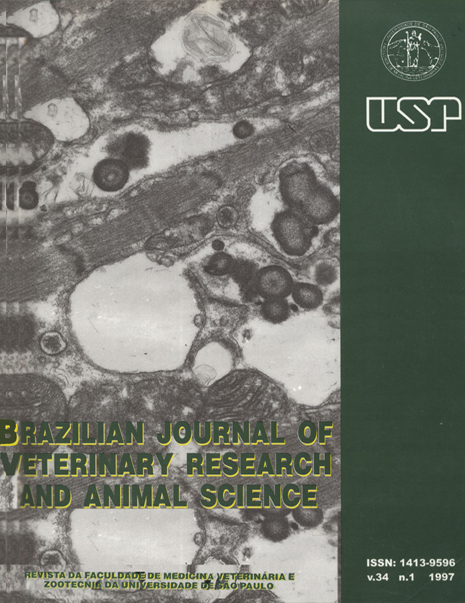Efficacy and persistence of cypermethrin 4.5% + DDVP 50% (Ectofarma®) in the control of Boophilus microplus and larvae of Dermatobia hominis on naturally infested crossbred dairy cattle
DOI:
https://doi.org/10.11606/issn.2318-3659.v34i1p44-47Keywords:
Boophilus microplus, Dermatobia hominis, Ectoparasiticides, Bovine, Cypermethrin, Dichlorvos, LarvaeAbstract
The effectiveness and persistence of Ectofarma* in the control of B. microplus and D. hominis larvae were evaluated. Initially, the effect on estimated reproduction and percentage of reduction was determined by dipping female ticks in 1:400 diluted solution of the product. The percentage of reduction was 95.34, and the reduction on hatchability of larvae was 100%. Then, in a field trial the product, in the same dilution, was handsprayed over a group of nine bovines. The number of ticks on treated and untreated animals were counted on days 0 ,1 ,2 ,3 ,7 ,1 4 ,2 1 , 28, 35 and 42 after treatment. D. hominis larvae were counted on day 3 and further, weekly, until the sixth week. The efficacy in vitro of Ectofarma" on the hatchability of B. microplus eggs was 100%. In the field trial this product was highly effective against ticks during 3 weeks, and ticks mean number on the treated group was lower than on control one, until thefourth week after treatment. Reduction of D.hominis larvae reached 65% on the third day post-treatment, and mean number of larvae in treated animals was always lower than the amount found in untreated ones.
Downloads
Download data is not yet available.
Downloads
Published
1997-02-01
Issue
Section
PREVENTIVE VETERINARY MEDICINE
License
The journal content is authorized under the Creative Commons BY-NC-SA license (summary of the license: https://
How to Cite
1.
Kasai N, Gennari SM, Nishi SM, Di Giacomo JP. Efficacy and persistence of cypermethrin 4.5% + DDVP 50% (Ectofarma®) in the control of Boophilus microplus and larvae of Dermatobia hominis on naturally infested crossbred dairy cattle. Braz. J. Vet. Res. Anim. Sci. [Internet]. 1997 Feb. 1 [cited 2024 Apr. 25];34(1):44-7. Available from: https://www.revistas.usp.br/bjvras/article/view/50237





